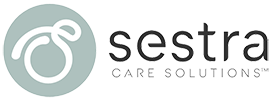The nursing and care staff at intermediate and long-term care facilities, hospitals and rehabilitation are frequently required to help to dress individuals. Due to the limited physical capabilities of a resident/ patient, dressing often entails repositioning and manual handling.
To enhance individuals’ care experience, creativity, experience, and initiatives of care staff and nurses focused on patients’ care and wellbeing, were put into the design of every detail of the Sestra Care Solutions brand and products.
The description and benefit of the unique details of the Sestra open-back shirt will help you see the rationale behind the design and the need for adapted/ personal clothing in care settings.
Special Features of Sestra Care Solutions Adaptive Clothing Garments
The unique cross-back design cross-over yoke and 2 cross-over panels. The yoke covers the shoulder blades, and the attached cross-over panels drop, to provide closure to the back of the garment. Garment length and style protect our client’s dignity, protects and help to keep their body temperature and provide them with a degree of independence in dressing themselves.
Our sleeve width and length are practical for accessing the arms and hands for care as well as medical treatment. The design protects the frail skin on the arms and elbows of clients.
The fabrics that are used are breathable, light in weight, skin-friendly, wrinkle resistant and adaptable with a general stretch. Our fabrics hold their colour and shape, industrial dryer and washing machine friendly.
We have eliminated the need for any studs, buttons, straps, or zips. Considerations are given to the positioning of tags and seams width and alignment of the garments; elements that may cause skin and body injury.
We have chosen to print a label on the inside of the garment that can have their name written with a permanent marker for easy identification. The family no longer needs to order expensive tags that must be sewn on each new garment.
Appropriately labelled garments prevent loss or misplacement of clothing. Having the clothing in the right place saves time and improves the dressing experience.
24/7 Style and colours choice Sestra shirts for men and women allow the garment to be worn through the day and at night and can easily be dressed up or down for visits and outings.
Adaptive clothing versus clothing options available and widely used
Patients’ care, health and dignity are always the main priority of every family, every care professional and care provider.
In saying this the options of clothing for patients with complex care needs in hospitals and aged care facilities are determined by the ease of dressing and undressing the patients. Facilitating easy access to the body, to providing care and treatments to achieve better health outcomes is the main goal.
Some of the commonly used and supplied patients’ clothing options/ adjustments and their shortcomings are listed below. Those garments are used for bed-confined patients when conventional clothing doesn’t provide the desired support and outcomes.
Cut up, split the back of a garment.
- Modifying for a purpose
- Need work to clean up the seams
- Back and shoulders parts are not covered
- Cold, revealing handling prosses
Oversize Conventional clothing
- Gape at the chest and back
- Leaves the patient’s bodies exposed to anyone standing nearby
- Needs accessories to look respectable.
- Pressure, sheers from creases and folds
- Hard to maintain buttons, zips, studs
Hospital gowns
Traditionally designed for those who are immobilized
- Ties at the back. Patients often need to wear more than one gown.
- Baggy, ill-fitting, revealing, scanty (barely enough to cover the back, showing part of the body)
- When tied up at the back it is challenging for those with limited flexibility or dexterity to tighten and secure the gown
- Patients in recovery complain of discomfort
- May contribute to the post-hospital syndrome
In highlighting the challenges of conventional clothing and hospital gowns, we would like you to see the benefit of Sestra open-back clothing and adaptive clothing in general. Consider open-back design clothing as a practical and more dignifying option of clothing for your elderly family member, client, or patient in your care.

